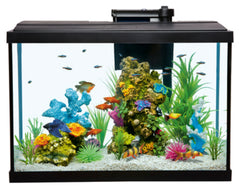Aquarium Nitrogen Cycle
Aquarium Nitrogen Cycle.

Aquarium Nitrogen Cycle: Understanding the Basics
If you are a beginner aquarist or planning to start an aquarium, it is essential to understand the aquarium nitrogen cycle. This natural process is vital to the health and survival of your fish and other aquatic organisms. In this article, we will discuss the basics of the aquarium nitrogen cycle, including what it is, why it is important, and how to maintain it.
What is the Aquarium Nitrogen Cycle?
The aquarium nitrogen cycle is a natural process that occurs in all aquariums. It is the process by which toxic ammonia, produced by fish waste and decaying organic matter, is broken down into less harmful nitrite and finally converted into nitrate. The process is carried out by beneficial bacteria that naturally colonize the aquarium's surfaces and filter media.
The process is divided into three stages: the first stage involves the conversion of ammonia to nitrite by the bacteria Nitrosomonas, while the second stage involves the conversion of nitrite to nitrate by the bacteria Nitrobacter. The final stage involves the removal of nitrate through water changes or biological filtration.
Why is the Aquarium Nitrogen Cycle Important?
The aquarium nitrogen cycle is critical for maintaining a healthy and stable aquarium ecosystem. Without the nitrogen cycle, toxic levels of ammonia and nitrite can quickly build up, causing harm and even death to your fish and other aquatic organisms. Nitrate, although less toxic than ammonia and nitrite, can also be harmful in high concentrations and contribute to algae growth and other issues.
Properly maintaining the nitrogen cycle in your aquarium ensures a safe and healthy environment for your aquatic pets, promotes beneficial bacterial growth, and reduces the need for frequent water changes.
How to Maintain the Aquarium Nitrogen Cycle
To maintain the aquarium nitrogen cycle, you need to ensure that beneficial bacteria are present and thriving in your aquarium. There are several ways to do this, including:
-
Cycling Your Aquarium
Cycling your aquarium is the process of establishing beneficial bacteria in your aquarium before adding fish or other aquatic organisms. This process involves adding a source of ammonia, such as fish food or pure ammonia, to the aquarium and allowing it to decay naturally. Over time, beneficial bacteria will colonize the aquarium and convert the ammonia into nitrite and then into nitrate. The process can take anywhere from 2-6 weeks, depending on various factors such as the size of the tank, the amount of ammonia added, and the water temperature.
-
Testing Water Parameters
Regularly testing your aquarium's water parameters is essential to maintain the nitrogen cycle. Ammonia, nitrite, and nitrate levels should be regularly monitored to ensure that they are within safe levels. Ammonia and nitrite levels should be undetectable, while nitrate levels should be kept below 40 ppm.
-
Biological Filtration
Biological filtration is the process of removing waste and other organic matter from the aquarium through beneficial bacteria. It involves using a filter that provides a large surface area for beneficial bacteria to colonize and grow. This bacteria converts ammonia and nitrite into nitrate, which can be removed through water changes or absorbed by live plants.
-
Water Changes
Water changes are an essential aspect of maintaining the nitrogen cycle. Regular water changes help to remove excess nitrate and other toxins, while also replenishing essential minerals and trace elements. Water changes should be done regularly, with the frequency and amount depending on various factors such as the size of the tank, the number of fish, and the level of nitrate in the water.
Conclusion
In conclusion, the aquarium nitrogen cycle is a vital process that occurs naturally in all aquariums. It is crucial to the health and survival of your livestocks.
Important: This is a general guide for beginners, and hobbyists are advised to factor in their tank conditions (e.g., types of fishes, number of fishes, feeding frequency, etc.) when following the advice. In no event shall we be liable for any claims, penalties, loss, damage or expenses, howsoever arising, out of or in connection with your use of this guide, including, without limitation, direct or indirect loss, consequential loss or damage. Nothing in these Terms and Conditions shall exclude or limit our liability for death or personal injury caused by negligence or for any liability which cannot be excluded or limited under applicable law.
